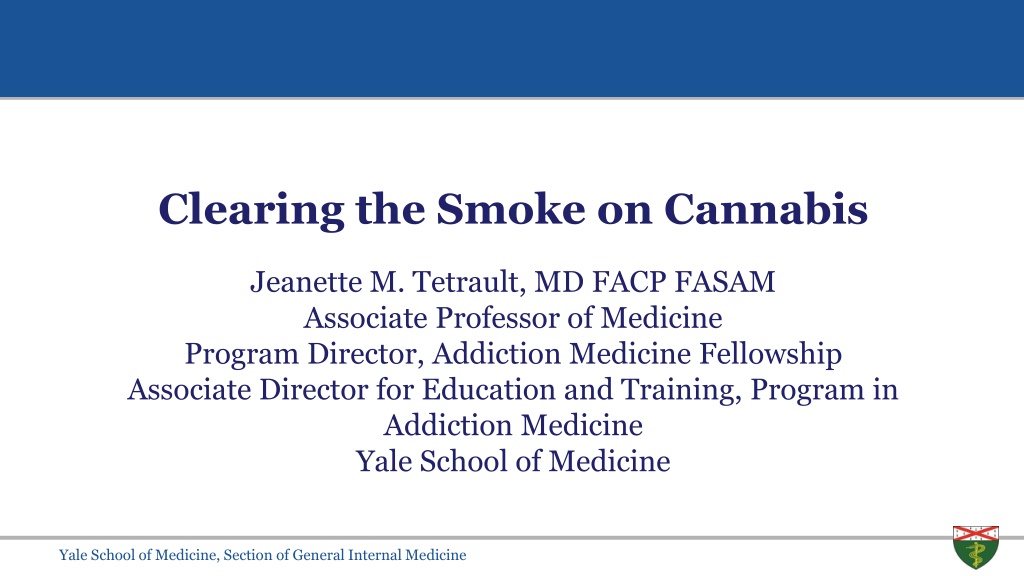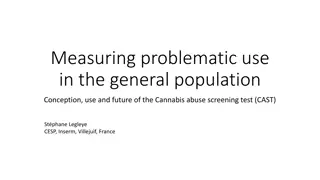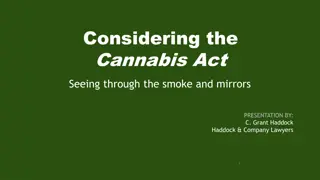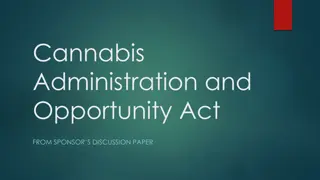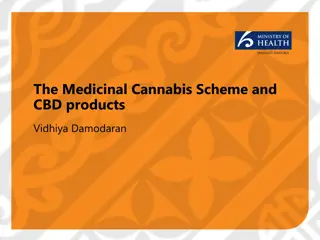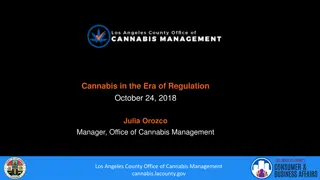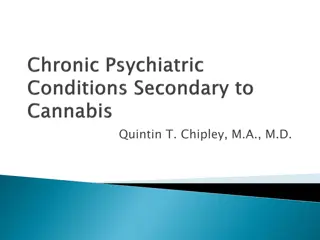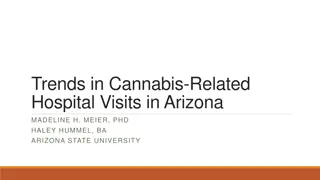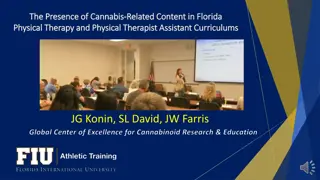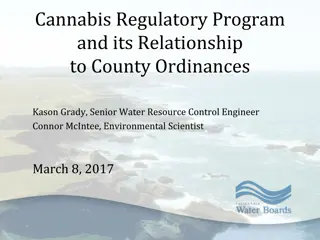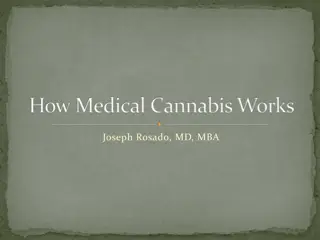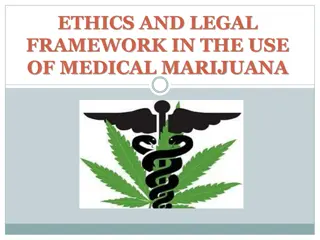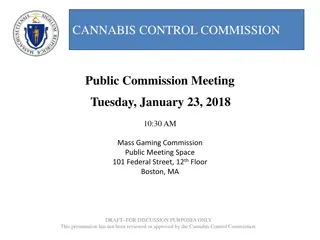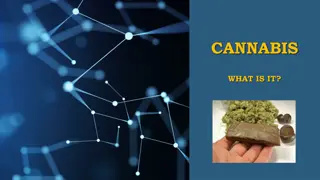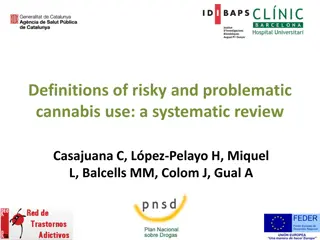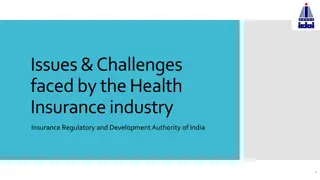Understanding Cannabis: Key Components, Health Effects, and Usage Trends
Delve into the world of cannabis as discussed by Dr. Jeanette M. Tetrault, exploring its components, potential health effects, and how it is used medicinally. Learn about the different species, main components like terpenes and cannabinoids, routes of administration, and the prevalence of cannabis use among various demographics.
Download Presentation

Please find below an Image/Link to download the presentation.
The content on the website is provided AS IS for your information and personal use only. It may not be sold, licensed, or shared on other websites without obtaining consent from the author. Download presentation by click this link. If you encounter any issues during the download, it is possible that the publisher has removed the file from their server.
E N D
Presentation Transcript
Clearing the Smoke on Cannabis Jeanette M. Tetrault, MD FACP FASAM Associate Professor of Medicine Program Director, Addiction Medicine Fellowship Associate Director for Education and Training, Program in Addiction Medicine Yale School of Medicine Yale School of Medicine, Section of General Internal Medicine
Clinical conundrum Yale School of Medicine, Section of General Internal Medicine
Learning objectives Define the key components of cannabis and review relevant epidemiology and terminology Briefly explore US policy regarding cannabis Summarize potential adverse health effects Examine the tension between health risks of cannabis vs. cannabis as medicine Yale School of Medicine, Section of General Internal Medicine
What is cannabis? Dried flowers, leaves, stems and seeds of Cannabis sativa Different species: Sativa Indica Two main components: Terpenes Cannabinoids Cannabidiol (CBD) 9-tetrahydrocannabinol (THC) Potency related to concentration of THC and route of administration Yale School of Medicine, Section of General Internal Medicine
Routes of administration Smoking Vaping activating raw plant matter without combustion ~40% of individuals with medical cannabis user vape as a route of administration Edibles Tinctures Transdermal patch Dabbing inhale cannabis vapor from concentrates, oils or extracts through a dab rig Delivers a high dose of THC in a short period of time Suppository Topical cream Beverage Yale School of Medicine, Section of General Internal Medicine
Past-month cannabis use 2015-2017 Yale School of Medicine, Section of General Internal Medicine
Cannabis use among young adults Yale School of Medicine, Section of General Internal Medicine
Why the increase? Daily Cannabis Use vs. Perceived Risk of Regular Cannabis Use among 12th Graders, 1975-2013 Yale School of Medicine, Section of General Internal Medicine
Policy timeline 1970: Controlled Substances Act passed by Congress, cannabis listed as schedule I drug 1996-2018: 11 states with recreational + medical, 36 states with medical only, 4 states illegal 2005: Supreme Court decision (Gonzales v. Raich) Federal law enforcement has the authority to arrest and prosecute MDs or patients 2009, 2014: Department of Justice Memorandum Federal resources should not be used to prosecute those who comply with states laws 2008-2010: IOM, ACP, AMA Petitioned DEA/FDA to reschedule to schedule II it remains schedule I to this day Yale School of Medicine, Section of General Internal Medicine
State-to-state variation Yale School of Medicine, Section of General Internal Medicine
Adverse effects of cannabis use Yale School of Medicine, Section of General Internal Medicine Volkow ND et al. NEJM 2014;370:2219-2227.
Moderate acute effects Acute cannabis intoxication agitation, psychosis, and anxiety tachycardia and hypertension Cannabinoid Hyperemesis Syndrome Pediatric Exposures Kim &Monte Annals of Em Med 2016 https://www.greenrushdaily.com/2016/08/17/cannabinoid- hyperemesis-syndrome-cannabis/ Yale School of Medicine, Section of General Internal Medicine
Cannabis Use Disorder DSM 5 A problematic pattern of cannabis use leading to clinically significant impairment or distress, as manifested by two or more of the following within a 12-month period: Cannabis is often taken in larger amounts or over a longer period than was intended There is a persistent desire or unsuccessful efforts to cut down or control cannabis use A great deal of time is spent in activities necessary to obtain cannabis, use cannabis, or recover from its effects Craving, or a strong desire or urge to use cannabis Yale School of Medicine, Section of General Internal Medicine
Cannabis Use Disorder, Contd Recurrent cannabis use resulting in a failure to fulfill major role obligations at work, school, or home Continued cannabis use despite having persistent or recurrent social or interpersonal problems caused or exacerbated by the effects of cannabis Important social, occupational, or recreational activities are given up or reduced because of cannabis use Recurrent cannabis use in situations in which it is physically hazardous Continued cannabis use despite knowledge of having a persistent or recurrent physical or psychological problem that is likely to have been caused or exacerbated by use Tolerance Withdrawal Yale School of Medicine, Section of General Internal Medicine
Cannabis withdrawal: New to DSM 5 Cessation of cannabis use that has been heavy and prolonged Three or more of the following signs and symptoms develop within approximately one week after the cannabis cessation: Irritability, anger, or aggression Nervousness or anxiety Sleep difficulty (eg, insomnia, disturbing dreams) Decreased appetite or weight loss Restlessness Depressed mood At least one of the following physical symptoms causing significant discomfort: abdominal pain, shakiness/tremors, sweating, fever, chills, or headache Cause distress or impairment No other explanation for symptoms Of note, symptoms generally resolve in 7-14 days but may persist for weeks Yale School of Medicine, Section of General Internal Medicine
16 person committee reviewed > 10,000 abstracts published since 1999 Focused on recently published systematic reviews and high quality primary research for 11 groups of health effects including both harms and therapeutic effects Report of National Academies of Science, Engineering and Medicine. Health Effects of Cannabis and Cannabinoids. 2017 Yale School of Medicine, Section of General Internal Medicine
Cumulative Probability of Transitioning to Substance Use Disorder for Nicotine, Alcohol, Cannabis and Cocaine Develop CUD: 9% of overall, 17% if begin during adolescence, 25-50% if daily use Lopez-Quintero, C. et al. Drug & Alcohol Dependence 2011 17 Yale School of Medicine, Section of General Internal Medicine
Health effects of cannabis and cannabinoids: SUD There is substantial evidence that: Initiating cannabis use at an earlier age is a risk factor for the development of problem cannabis use There is moderate evidence of a statistical association between cannabis use and: The development of substance use disorder for substances, including alcohol, tobacco, and other illicit drugs Report of National Academies of Science, Engineering and Medicine. Health Effects of Cannabis and Cannabinoids. 2017 Yale School of Medicine, Section of General Internal Medicine
Adolescent vulnerability in IQ decline Meier M H et al. PNAS 2012 Yale School of Medicine, Section of General Internal Medicine
Health effects of cannabis and cannabinoids: Psychosocial domains There is moderate evidence of a statistical association between cannabis use and: The impairment in the cognitive domains of learning, memory, and attention Report of National Academies of Science, Engineering and Medicine. Health Effects of Cannabis and Cannabinoids. 2017 Yale School of Medicine, Section of General Internal Medicine
Association between mental health conditions and cannabis use Yale School of Medicine, Section of General Internal Medicine Blanco et al JAMA Psychiatry, 2016
Health effects of cannabis and cannabinoids: Mental Health There is substantial evidence of a statistical association between cannabis use and: The development of schizophrenia or other psychoses, with the highest risk among the most frequent users There is moderate evidence of a statistical association between cannabis use and: Increased symptoms of mania and hypomania in individuals diagnosed with bipolar disorders (regular cannabis use) A small increased risk for the development of depressive disorders Increased incidence of suicidal ideation and suicide attempts with a higher incidence among heavier users Increased incidence of suicide completion Increased incidence of social anxiety disorder (regular cannabis use) Major depressive disorder is a risk factor for the development of problem cannabis use Report of National Academies of Science, Engineering and Medicine. Health Effects of Cannabis and Cannabinoids. 2017 Yale School of Medicine, Section of General Internal Medicine
Pulmonary effects of smoked cannabis Acute bronchodilation (FEV1 increase ~ 0.15-0.25L) Long-term cough (OR 2.0, 95% CI 1.32-3.01), phlegm, wheeze; however data were inconclusive regarding an association between long-term cannabis smoking and airflow obstruction(1) At low levels of exposure, FEV1 increased by 13 mL/joint- year and FVC by 20 mL/joint-year, but at higher levels of exposure, airflow obstruction was observed(2) Tetrault JM et al. Archives IM 2007 Pletcher MJ et al. JAMA 2012 Yale School of Medicine, Section of General Internal Medicine
Health effects of cannabis and cannabinoids: Respiratory disease There is substantial evidence of a statistical association between cannabis smoking and: Worse respiratory symptoms and more frequent chronic bronchitis episodes (long-term cannabis smoking) There is moderate evidence of a statistical association between cannabis smoking and: Improved airway dynamics with acute use, but not with chronic use Higher forced vital capacity (FVC) There is moderate evidence of a statistical association between the cessation of cannabis smoking and: Improvements in respiratory symptoms Report of National Academies of Science, Engineering and Medicine. Health Effects of Cannabis and Cannabinoids. 2017 Yale School of Medicine, Section of General Internal Medicine
Trends in fatal motor vehicle crashes before and after cannabis commercialization in CO Salomonsen-Sautel, S. Drug & Alcohol Dependence, 2014 Yale School of Medicine, Section of General Internal Medicine
Health effects of cannabis and cannabinoids: Injury and death There is substantial evidence of a statistical association between cannabis use and: Increased risk of motor vehicle crashes There is moderate evidence of a statistical association between cannabis use and: Increased risk of overdose injuries, including respiratory distress, among pediatric populations in U.S. states where cannabis is legal (9-4b) Report of National Academies of Science, Engineering and Medicine. Health Effects of Cannabis and Cannabinoids. 2017 Yale School of Medicine, Section of General Internal Medicine
Treatment Options for cannabis use disorder Pharmacotherapy No currently approved medication cannabinoid antagonist oral THC for withdrawal, maintenance or short-term treatment? cannabinoid agonist Levin FR DAD 2011 N-Acetylcysteine Behavioral Substance use treatment setting cognitive-behavioral therapy, contingency management, motivational enhancement, therapeutic living General medical settings Brief interventions Yale School of Medicine, Section of General Internal Medicine
Synthetic cannabis: K2, Spice, etc. General Information: Marketed as safe legal alternative to cannabis; generally smoked; very common among adolescents Effects: Mild euphoria and relaxation The giggles Increased sensitivity to external stimuli Frank, vivid hallucinations Adverse effects: Dry mouth, palpitations, rapid HR, vomiting, agitation Not detected in urine May be adulterated with heavy metal residues or other fillers including rat poison- severe bleeding Yale School of Medicine, Section of General Internal Medicine
Fundamental tension Intoxication and withdrawal of cannabis are not fatal Overdose is unlikely Long-term, moderate use seems to be relatively frequent (compared to other drugs) Risk of end-organ damage appears to be lower than several other legal and illegal substances Ratio of medical benefit to harm may be equal or better than some controlled substances Yale School of Medicine, Section of General Internal Medicine
Health effects of cannabis and cannabinoids: Therapeutic effects There is conclusive or substantial evidence that cannabis or cannabinoids are effective: For the treatment of chronic pain in adults (cannabis) As antiemetics in the treatment of chemotherapy-induced nausea and vomiting (oral cannabinoids) For improving patient-reported multiple sclerosis spasticity symptoms (oral cannabinoids) Report of National Academies of Science, Engineering and Medicine. Health Effects of Cannabis and Cannabinoids. 2017 Yale School of Medicine, Section of General Internal Medicine
Cannbinoids for medical use: Pain 30% decrease in pain w cannabinoid vs placebo: OR 1.41 (95% CI, 0.99-2.00) Yale School of Medicine, Section of General Internal Medicine Whiting PF et al. JAMA.2015;313(24):2456-2473
Medical Cannabis and OD risk Bachhuber MA et al. JAMA 2014 Yale School of Medicine, Section of General Internal Medicine
Cannabis legislation and prescription opioids Between 2011-2016, among Medicaid enrollees, medical cannabis laws associated with 5.88% lower opioid prescribing rates Between 2010-2015, among Medicare part D recipients, prescriptions filled for all opioids decreased by 2 million daily doses per year when a state instituted any medical cannabis law. Prescriptions for all opioids decreased by 3.742 million daily doses per year when medical cannabis dispensaries opened. Cannabis use associated with increase in nonmedical use of prescription opioids (OR 5.78, 95% CI 4.23-7.9) Cannabis use associated with OUD (OR 7.76, 95% CI 4.95-12.2) Wen, H et al, JAMA Internal Medicine Apr 2018 Bradford AC et al. JAMA Internal Medicine Apr 2018 Hill KP et al, JAMA Internal Medicine Apr 2018 Olfson M et al. Am J Psychiatry 2018 Yale School of Medicine, Section of General Internal Medicine
Challenges in conducting research on adverse health effects or therapeutic effects of cannabis Regulatory barriers, including the classification of cannabis as a Schedule I substance, impede the advancement of cannabis research Difficult for researchers to gain access to the quantity, quality, and type of product necessary to address research questions on health effects A diverse network of funders is needed to support cannabis research To develop conclusive evidence for the effects of cannabis use on short- and long-term health outcomes, improvements and standardization in research methodology (including those used in controlled trials and observational studies) are needed Report of National Academies of Science, Engineering and Medicine. Health Effects of Cannabis and Cannabinoids. 2017 Yale School of Medicine, Section of General Internal Medicine
Yale School of Medicine, Section of General Internal Medicine JAMA. 2019;321(7):639-640. doi:10.1001/jama.2019.0077
For the opioid addiction crisis, clearly efficacious medications such as methadone and buprenorphine are under-prescribed. Without convincing evidence of efficacy of cannabis for this indication, it would be irresponsible for medicine to exacerbate this problem by encouraging patients with opioid addiction to stop taking these medications and to rely instead on unproven cannabis treatment. Yale School of Medicine, Section of General Internal Medicine JAMA. 2019;321(7):639-640. doi:10.1001/jama.2019.0077
Reducing potential harm from cannabis use Caution with edibles Describe long onset of action/labelling concerns Safe storage Caution with high THC products 58 mg THC in a joint don t smoke the whole joint Certain routes of administration i.e., dabbing carry particular risk Consider use of products with lower THC, higher CBD Cut back employ brief intervention Yale School of Medicine, Section of General Internal Medicine
Back to the caseWhat would you do? Yale School of Medicine, Section of General Internal Medicine
Interactive teaching scenario: Morning report/role play Set up a spicy, public health debate regarding legalization of recreational marijuana using the following citation as a spring board for discussion: Kilmer B. Recreational Cannabis Minimizing the Health Risks from Legalization. Perspective. NEJM. February 23, 2017 Assign report participants to one of two groups: Recreational marijuana SHOULD be legalized in all states nationwide Citing adverse effects of criminalization and potential for increasing state budgets through taxation, potential impact on opioid epidemic Recreational marijuana SHOULD NOT be legalized in all states nationwide Citing current research on adverse health effects and natural experiment data from states that have already legalized recreational marijuana All arguments need to be evidence-based and factual Yale School of Medicine, Section of General Internal Medicine
Thank you Questions? Acknowledgements: several slides adapted from Dr. William Becker (Yale), Dr. Devan Kansagara (OHSU) Dr. Hilary Kunins (NY DPH), Dr. Jeffrety Hunt (Brown), Dr. Zoe Weinstein (BU) Yale School of Medicine, Section of General Internal Medicine
